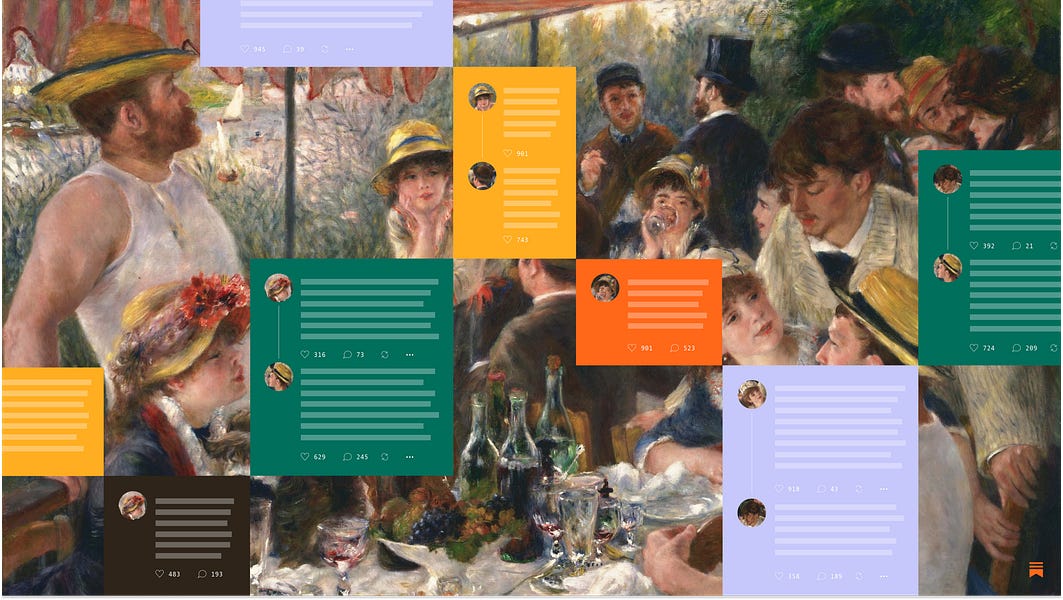Quillette Cetera
I’m Loving Substack’s New ‘Notes’ Service. But Can the Good Times Last?
Much as Substack originally supplied writers with a turnkey newsletter operation, Notes provides us with a turnkey form of community-building.

Last week, Substack CEO Chris Best was dressed down on the Verge’s Decoder podcast for refusing to tell host Nilay Patel whether users would be allowed to remain on Substack’s new Twitter-like Notes service for making racist statements such as (this was the host’s example) “all brown people are animals and they shouldn’t be allowed in America.” Best said he wasn’t going to speculate on hypothetical cases, which caused Patel to sanctimoniously lecture the CEO about how he’d flunked an important moral litmus test: “You know this is a very bad response to this question, right? You’re aware that you’ve blundered into this. You should just say no. And I’m wondering what’s keeping you from just saying no.”
No one likes racist trolls on social media. But Best was perfectly correct to resist Patel’s line of questioning. Once you set hard and fast rules for what you’re allowed to say or not allowed to say on a platform, the first thing people do is figure out how (a) to communicate the same idea in veiled form; and (b) to get their enemies suspended by reporting them, in bad faith, for communicating the forbidden words as a joke or thought experiment (e.g., reporting Patel for saying the words, “all brown people are animals”). I’m not a free-speech absolutist. Some safeguards do need to be in place. But setting down granular, content-specific rules is a formula for false positives and false negatives alike.
In any case, the best kind of content moderation is the kind you never have to do, since the users on your network don’t want to say awful things—either because they’re the sort of people who aren’t apt to say awful things to begin with, or because they recognize that they’re in a space where that kind of content is stigmatized.

From what I’ve seen of Notes over the last two weeks, I’d say that’s exactly the kind of service it offers: The people I follow, and who follow me, tend to be Substackers whose Substacks I read, and/or who read mine—which is to say, writers, pundits, hobbyists, hams, podcasters, academics, and comedians manqué who share at least some of my interests and quirks. In many cases, we’ve had passing professional or social contact in the past. Even in the unlikely event that any of us were moved to say something hateful such as “all brown people are animals,” none of us would do so because we’d (rightly) be shunned.
I have no idea if this good-manners ethos can survive as Notes scales up its user base and interactions with strangers become more common. But right now, I’m really enjoying it. On Twitter, I go into every comment thread half-expecting a scathing rebuttal or even a personal insult. And so I, in turn, am more likely to make some barbed (usually sardonic) comment upon being provoked. On Notes, I don’t go in with that expectation.
This kind of social dynamic tends to exhibit non-linear characteristics, so even a small reduction in users’ expectations of abusive interactions can have a massive effect on the likelihood of negative interactions. Thus, when trolls do eventually creep into the Notes ecosystem (as seems inevitable), they might not succeed in tipping the platform into toxic Twitter territory.

This week, I spoke at length with an executive at Substack (not Best, though I’ve had him on the Quillette podcast a few times) who was interested in understanding how Substack might be put to use by an operation such as Quillette. What I told him was that the emergence of Notes will likely revolutionize the way journalists (and not just at Quillette) think of Substack. In the long run, in fact, Notes may prove to be so popular that it basically swallows up the whole Substack brand.
As a journalist, my pre-Notes take on Substack was this: It makes for a fun, easy-to-use platform for all the content that didn’t quite make the grade at my “real” job. So if you look at my Deeply Problematic Substack (which I am not going to link to, lest I be accused of trying to attract subscribers), it’s mostly about teacup-tempest Canadian culture-war stories that probably wouldn’t interest Quillette’s (largely non-Canadian) readership. My Let’s Get Board boardgaming Substack is even more obscure (sample headline: Getting Back Into Action at Toronto Area Boardgame Society: Downforce, Terraforming Mars, Let’s Make a Bus Route, and Pendragon: The Fall of Roman Britain). Which is to say that Substack traditionally hasn’t been particularly relevant to my journalism. It’s just a leftovers tray for my B-rate ideas.
That isn’t to say that Substack hasn’t upended journalism more generally. It has. But in most (though certainly not all) cases, this hasn’t been the case of journalists operating a popular, money-earning Substack in parallel with his or her traditional day-job journalism. Rather, it’s usually a case of a journalist becoming really focused on one particular issue, then quitting his or her day job (assuming he or she even had one) and starting a profitable Substack that caters to a niche interest. For these people, Substack has been great, because you only need a thousand or so monthly subscribers to make your living off the platform. But by means of this kind of “narrow-casting,” you also tend to pigeonhole yourself into one topic, which can have long-term career consequences. And, selfishly, as an editor, I don’t like it, because I’ve seen some of my writers pass up Quillette’s freelance fees so they can run their own shop at Substack.
Notes, by contrast, will have a complementary relationship with traditional journalism—because the fare people tend to write on Notes, while much longer than tweets in most cases, isn’t the sort of essay-length material one traditionally sees on Substack. Notes tends to be more in the realm of riffs, queries, anecdotes, lists, synopses, mini-reviews, and such—material that’s too insubstantial to appear in a newspaper, magazine, or standalone Substack post, but (and this is crucial) that’s substantial enough to showcase one’s knowledge and interests to other intellectually curious people.
This is why, in scarcely more than 10 days, I’ve already recruited several new writers on Notes. On Twitter, I score points. On Notes, I score contacts. The experience often feels like you’re on some sort of weird version of LinkedIn that’s made for exactly that sort of person who has very strong opinions about Sam Harris.
I have no idea if this will last, as the first people who get on any social media platform tend to be idealistic about its uses. (Remember those 15 minutes in 2022, when half your friends were like, “See you on Mastodon, on the banks of the beautiful River Wah-Hoo, where they never have trolls, at least very few”?) In particular, I’ll be interested to see how Best and his team adjust the dial setting that governs barriers to entry. Turn that dial too high—say, by restricting use to content-generating Substackers with government ID and/or a credit card on file—and you’ll end up with a hen-party for Quillette types that eventually feels tiny and insular. But turn it too low, and you’ll simply be creating a new kind of Twitter. We already have one Twitter. And on many days, that feels like one too many.
I really hope that Best gets the balance right, because—again, selfishly—Notes can provide Quillette and similar thought-driven niche journalistic outlets with something extremely valuable: Much as the original Substack model supplied writers with a turnkey newsletter operation (complete with revenue-collecting and promotional tools), Notes provides us with a turnkey community-building operation.
What I mean by this is that Notes can help solve the problem of how Quillette’s core audience and supporters communicate with us and each other. Yes, we often allow user comments under our articles, but those tend to be written by the same small group of people, and are read by relatively few others. Twitter provides some form of communal interaction, but only in the context of a much louder and noisier forum. Not every editor or writer enjoys social media. And even at its best, this kind of Twitter dialogue ends up feeling like a huddle of close friends trying to converse with one another from across a crowded room of (sometimes hostile) strangers.

This is one of the reasons why our bricks-and-mortar Quillette Socials have proven so popular. When I was in New Orleans in January for our most recent event, I was shocked at how far some people had travelled. It speaks to their hunger for a sense of community that cannot be satisfied by existing electronic means.
I have no illusions that Notes (or any other digital service) will replace in-person meet-ups. But so far, it does feel like the kind of friendly, interesting electronic salon that many of us always wanted social media to be. Again, I don’t know if it’ll last. But for the moment, I’m enjoying the ride.







